MICROSCOPE-ANTIQUES.COM © 2013-15.
GRAND VAN HEURCK MICROSCOPE (modified Rousselet Compressor):
c. 1913
Maker: W. WATSON & SONS LTD.
DESCRIPTION:
 This well made compressor measures **** X ****.
It is signed:
This well made compressor measures **** X ****.
It is signed: W.Watson & Sons, Ltd London
. It is made mainly of lacquered brass. A round piece of glass, slightly less than 1 mm thick, is permanently mounted to the bottom plate, protruding slightly above the surface of the brass. As the Sprung pins in the top plate are pressed down, a (rectangular)coverslip can be placed on the underside of the top plate, and when the pins are released, the coverslip is held in place by the caps at the bottom of the pins. These pins have thin pieces of cork on the side facing the coverslip. The bottom plate has cutouts to allow the pin nearest the compression knob in the top plate ample clearance when pushed down while the top plate is opened 90 degrees. The round top plate opening has blackened and tapered edges to allow an objective to reach the edges of the opening. The top plate is prevented from rotating as the knob is turned, but can be manually rotated out of the way when desired, to provide access the bottom plate, or to replace the coverglass on its underside. An internal 'spring catch' holds the top plate in the position it is used for compression, and also at 90 degrees from the usual position.
HISTORY:
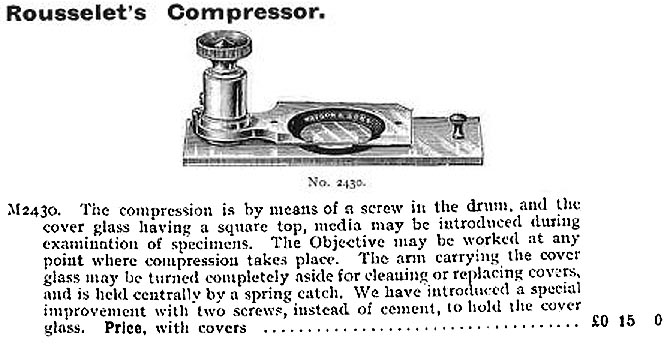 A similar compressor was invented by Charles Rousselet, FRMS 'about 1890'. It was first noted and reported in the JRMS in 1893, but subsequently modified by Watson and others. These modifications gave slight increases in convenience, while at the same time reducing the usefulness of the device. This is because the top coverslip, being held against the top plate does not form a seal and so any oil or other material on top of the slip could leak into the area where the specimen is being held. A better design, and to my knowledge never made, would have been to use a rubber interface between the coverslip and the top ring. (see Rousselet, CF, A Description of the Rousselet Compressorium, JQMC vol IX, 1904-1906 p 137-8). The model shown in the engraving to the left from the 1912-13 Watson catalog, is similar to the model shown above. The sprung pins instead of screws are an interesting difference. Screws were originally applied from below to hold the top coverslip in place without glue. In the version seen above on this page, the spring loaded pins could simply be pushed down, a coverslip placed on the plate, and the coverslip would be held in place as the pins were released. A later variation of this compressor was supplied in Aluminum. Watson's 'improved' Rouselet compressor was sold for many years, still being offered in the 1945 catalog. I could not find any catalog entry that illustrated the sprung pins however. When this variation with sprung pins was made, and for how long it was offered, is a mystery.
A similar compressor was invented by Charles Rousselet, FRMS 'about 1890'. It was first noted and reported in the JRMS in 1893, but subsequently modified by Watson and others. These modifications gave slight increases in convenience, while at the same time reducing the usefulness of the device. This is because the top coverslip, being held against the top plate does not form a seal and so any oil or other material on top of the slip could leak into the area where the specimen is being held. A better design, and to my knowledge never made, would have been to use a rubber interface between the coverslip and the top ring. (see Rousselet, CF, A Description of the Rousselet Compressorium, JQMC vol IX, 1904-1906 p 137-8). The model shown in the engraving to the left from the 1912-13 Watson catalog, is similar to the model shown above. The sprung pins instead of screws are an interesting difference. Screws were originally applied from below to hold the top coverslip in place without glue. In the version seen above on this page, the spring loaded pins could simply be pushed down, a coverslip placed on the plate, and the coverslip would be held in place as the pins were released. A later variation of this compressor was supplied in Aluminum. Watson's 'improved' Rouselet compressor was sold for many years, still being offered in the 1945 catalog. I could not find any catalog entry that illustrated the sprung pins however. When this variation with sprung pins was made, and for how long it was offered, is a mystery.
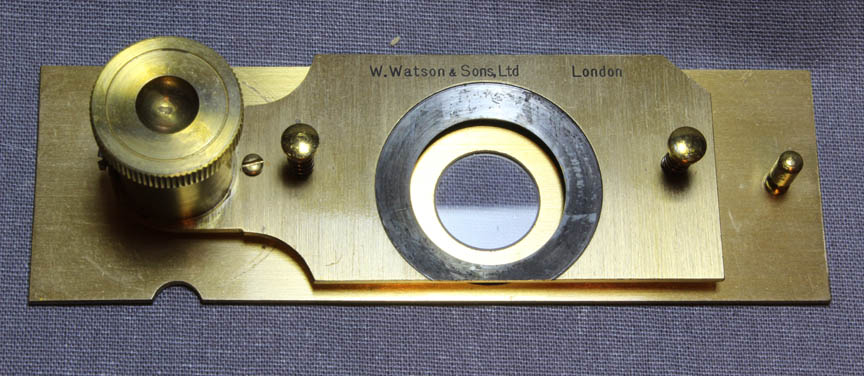
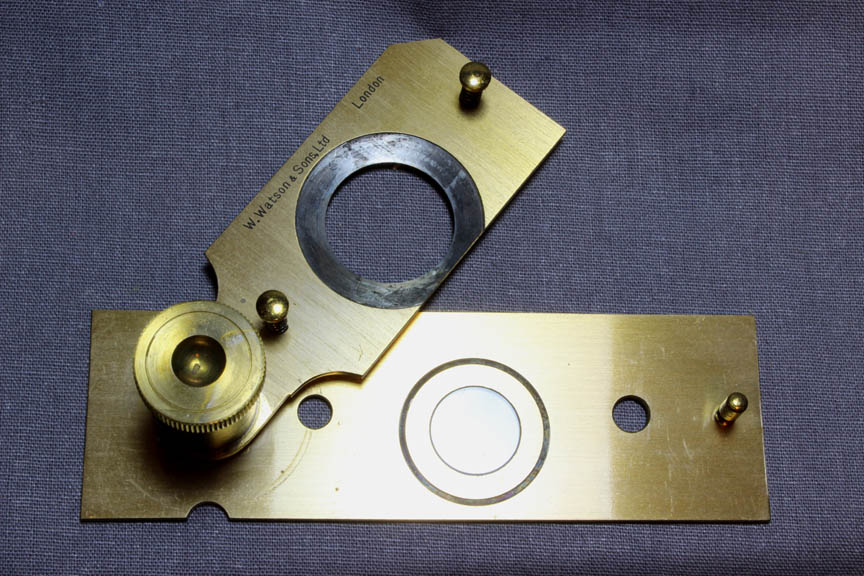
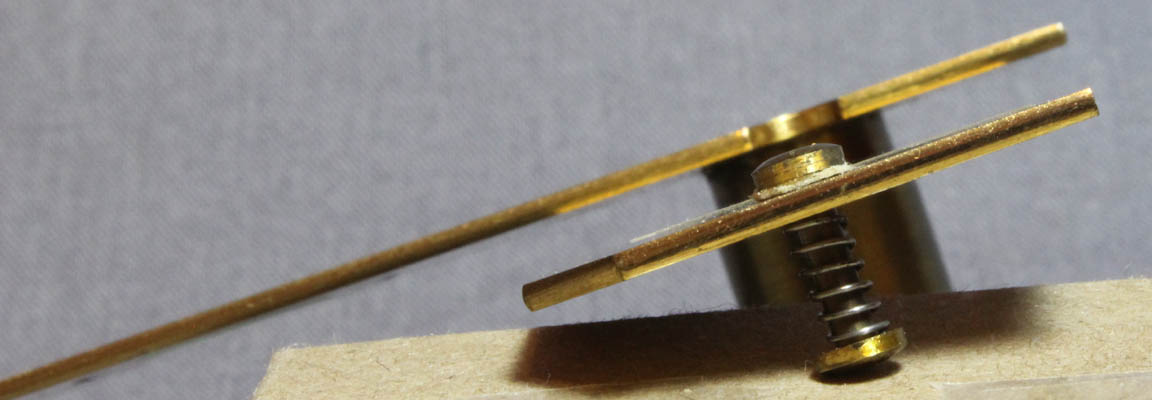
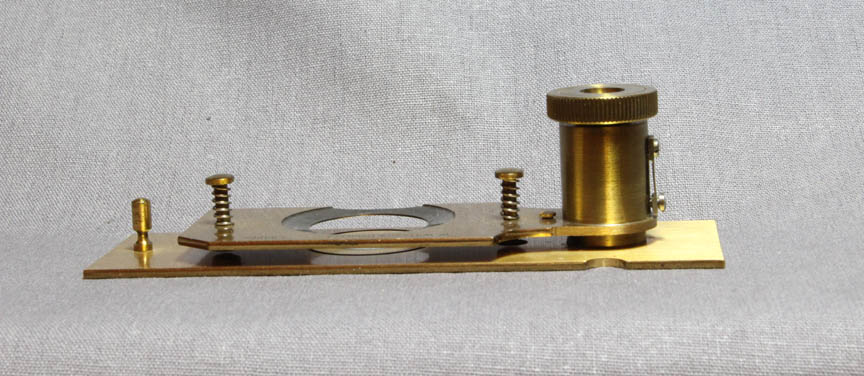
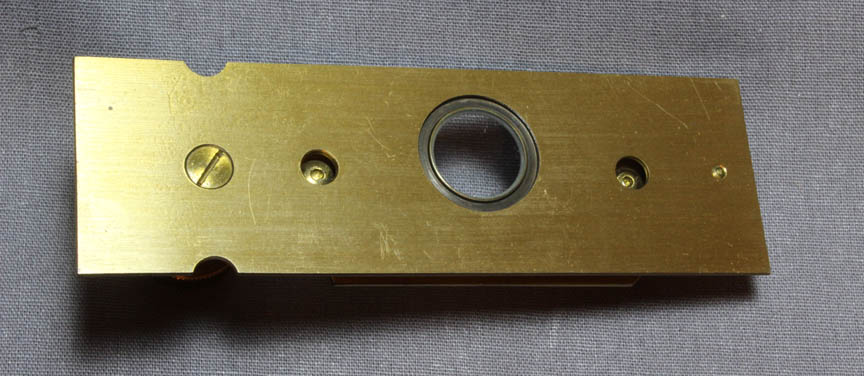
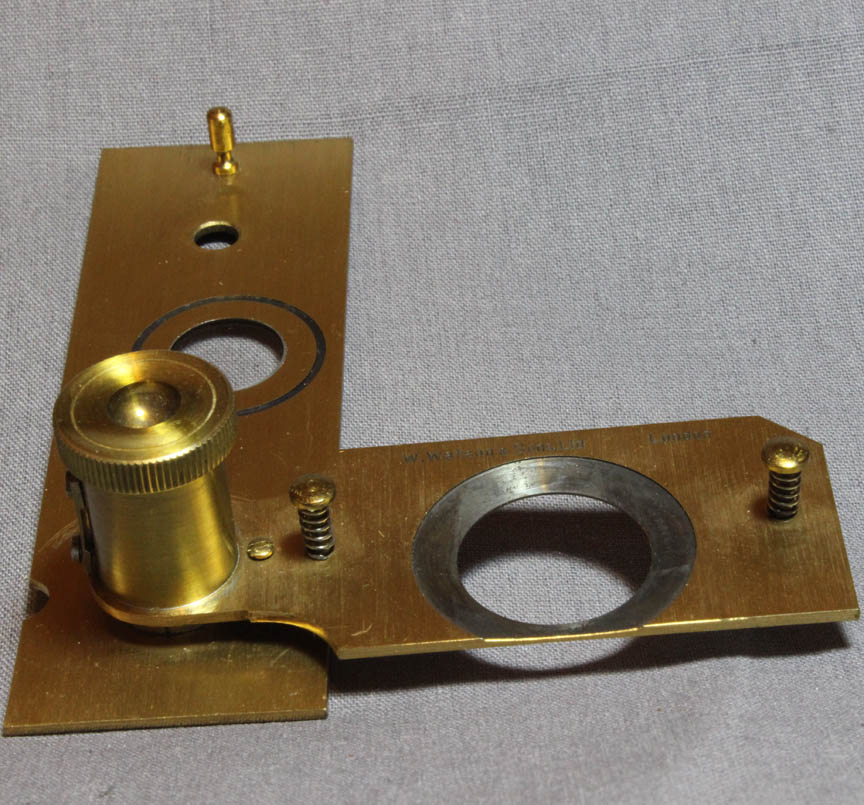
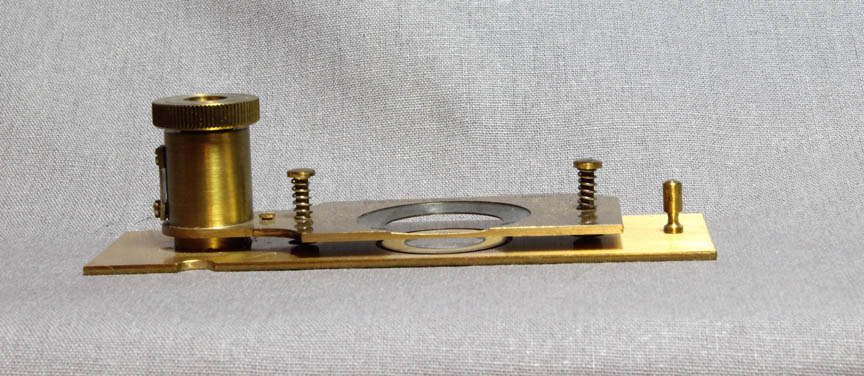
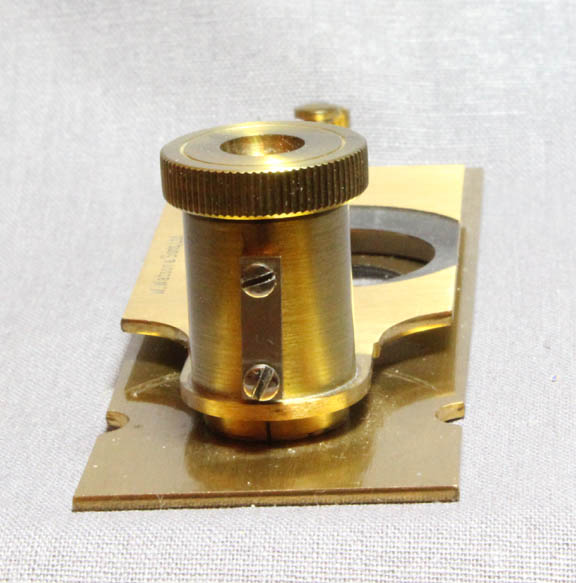
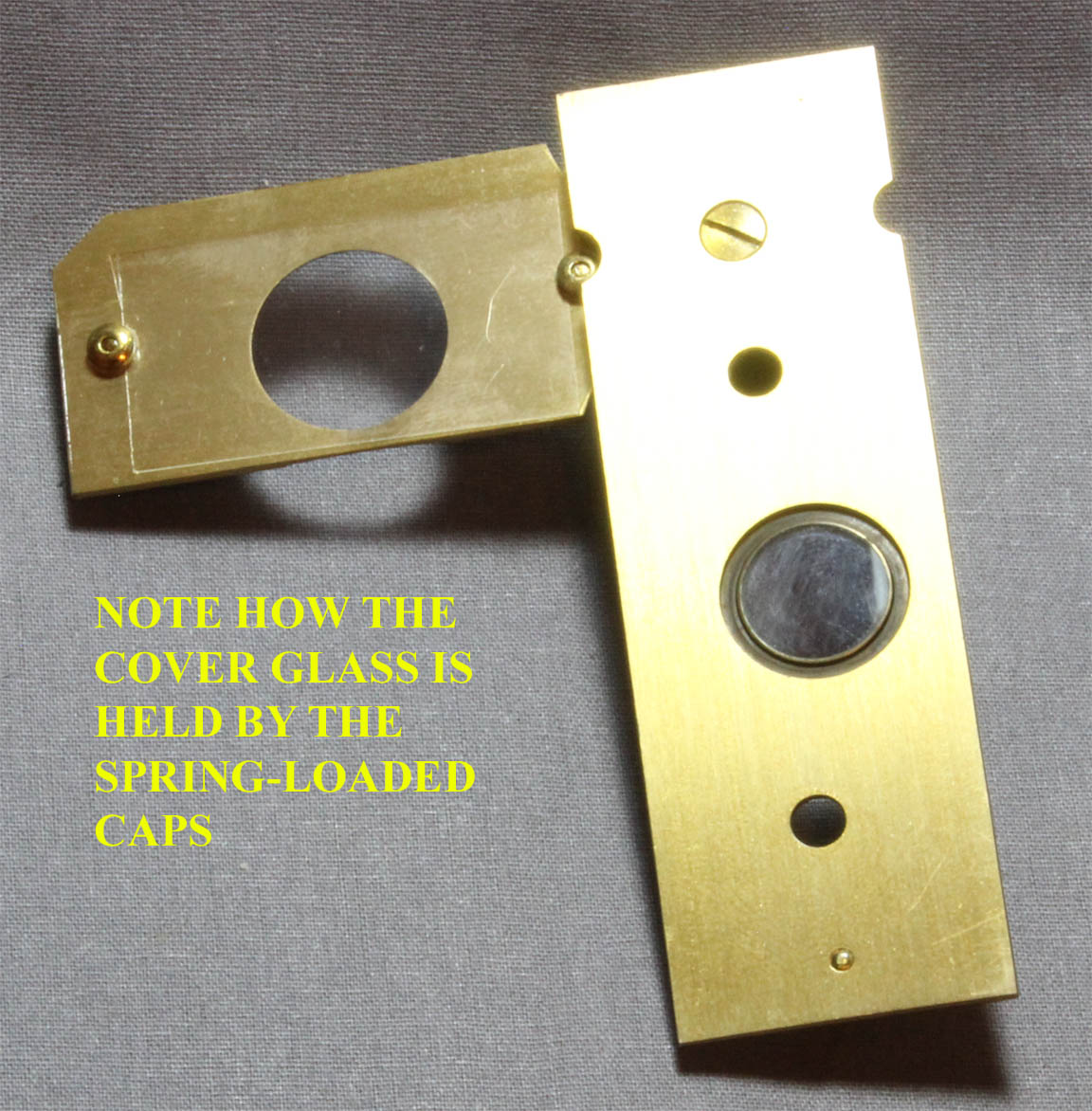
 This well made compressor measures **** X ****.
It is signed:
This well made compressor measures **** X ****.
It is signed:  A similar compressor was invented by Charles Rousselet, FRMS 'about 1890'. It was first noted and reported in the JRMS in 1893, but subsequently modified by Watson and others. These modifications gave slight increases in convenience, while at the same time reducing the usefulness of the device. This is because the top coverslip, being held against the top plate does not form a seal and so any oil or other material on top of the slip could leak into the area where the specimen is being held. A better design, and to my knowledge never made, would have been to use a rubber interface between the coverslip and the top ring. (see Rousselet, CF, A Description of the Rousselet Compressorium, JQMC vol IX, 1904-1906 p 137-8). The model shown in the engraving to the left from the 1912-13 Watson catalog, is similar to the model shown above. The sprung pins instead of screws are an interesting difference. Screws were originally applied from below to hold the top coverslip in place without glue. In the version seen above on this page, the spring loaded pins could simply be pushed down, a coverslip placed on the plate, and the coverslip would be held in place as the pins were released. A later variation of this compressor was supplied in Aluminum. Watson's 'improved' Rouselet compressor was sold for many years, still being offered in the 1945 catalog. I could not find any catalog entry that illustrated the sprung pins however. When this variation with sprung pins was made, and for how long it was offered, is a mystery.
A similar compressor was invented by Charles Rousselet, FRMS 'about 1890'. It was first noted and reported in the JRMS in 1893, but subsequently modified by Watson and others. These modifications gave slight increases in convenience, while at the same time reducing the usefulness of the device. This is because the top coverslip, being held against the top plate does not form a seal and so any oil or other material on top of the slip could leak into the area where the specimen is being held. A better design, and to my knowledge never made, would have been to use a rubber interface between the coverslip and the top ring. (see Rousselet, CF, A Description of the Rousselet Compressorium, JQMC vol IX, 1904-1906 p 137-8). The model shown in the engraving to the left from the 1912-13 Watson catalog, is similar to the model shown above. The sprung pins instead of screws are an interesting difference. Screws were originally applied from below to hold the top coverslip in place without glue. In the version seen above on this page, the spring loaded pins could simply be pushed down, a coverslip placed on the plate, and the coverslip would be held in place as the pins were released. A later variation of this compressor was supplied in Aluminum. Watson's 'improved' Rouselet compressor was sold for many years, still being offered in the 1945 catalog. I could not find any catalog entry that illustrated the sprung pins however. When this variation with sprung pins was made, and for how long it was offered, is a mystery.